Resynthesizing sound via spectogram¶
After we took a look how we can generate sounds in Python via numpy we want to take a look how we can re-synthesize a signal using numpy and some machine learning algorithms we have learned. This allows us to yield interesting high-quality sounds without relying on neural networks that are exhausive on resources.
Instead of writing audio analysis algorithms from scratch we can use the library librosa which is a library build with the help of numpy.
import numpy as np
import pandas as pd
import matplotlib.pyplot as plt
import matplotlib as mpl
import librosa
import librosa.display
from IPython.display import display, Audio
# remove warning in plotting via librosa
import warnings
import matplotlib.cbook
warnings.filterwarnings("ignore",category=matplotlib.cbook.mplDeprecation)
np.random.seed(42)
mpl.rcParams['figure.figsize'] = (15, 8)
Loading a sound file¶
path = 'trumpet.flac'
data, sr = librosa.load(path, sr=None, mono=True)
display(Audio(path))
We start by loading a recording of a trumpet.
We set the samplerate to None because otherwise librosa will not use the original samplerate of the file but will downsample the signal to \(22'050~\text{Hz}\), which is handier from a computational point of view as it contains less data, but not very pleasing from an aesthetic experience.
We will also force the signal to be mono, but this could be an interesting extension to the algorithm.
As librosa.load returns two values we can unpack this list by declaring two values on the left side.
data will contain the data of our audio signal in a PCM (Pulse Code Modulation) format, which gives us for each point in time its amplitude.
The resolution of the time domain is defined by the samplerate, which is stored in variable sr.
The resolution of the amplitude is given by its bitsize.
16 bits allow for \(2^{16} = 65'536\) discerete values and 24 bits allow for \(2^{24} = 16'777'216\) discrete values of resolution.
For this notebook we will use trumpetsolo1_hikmet.aiff by emirdemirel from freesound.org (converted to 16 bit FLAC) but you are welcome to exchange the file with another one.
We can take a look at data which is simply an array of the amplitude floats in time.
data
array([ 0.0000000e+00, -3.0517578e-05, 6.1035156e-05, ...,
4.5776367e-04, 1.2207031e-04, -1.5258789e-04], dtype=float32)
data.shape
(896841,)
data is a single vector in time and we can verify the length of the signal by dividing it with our samplerate sr.
print(f"Samplerate is {sr}")
print(f"Length of the signal in seconds: {data.shape[0]/sr}")
Samplerate is 44100
Length of the signal in seconds: 20.336530612244896
FFT¶
Before we talk about the infamous FFT we need to talk about Fourier analysis, especially the Fourier series. The Fourier series allows us to deconstruct any given periodic function into a series of summed sines and cosines, so
where \(a_k, b_k \in \mathbb{R}\). This may seem a bit underhelming at first but it is indeed not trivial that we can describe any periodic (“repeating”) function as a sum of sine and cosines. As we increase the number of \(k \in \mathbb{N}\) we increase the resolution and therefore come closer to the signal we want to approximate.
But there is one problem: The audio signal we want to analyze is most of the time not periodic but aperiodic. It turns out that this problem can be solved by the Fourier transformation which is generalization of the former mentioned Fourier series. This Fourier transformation works on continous signals and returns a continous spectrum (the space of time, frequency and amplitude) which works well in a mathematical context but computers need discrete signals - in the end computers work binary and rely on discrete values. For more information about the resolution we refer to the groundbreaking paper On Computable Numbers, with an Application to the Entscheidungsproblem by Alan Turing [Tur36]. The difference between discrete and continious is indeed not trivial as it may seems and for a proper definition of these terms rely on measure theory and topology. A classical example form statistics is that the height of a person is continous (as there are infinite many infinitesimal possibilities between \(160~\text{cm}\) and \(161~\text{cm}\)) and the outcome of rolling a traditional dice is finite (1,2,3,4,5,6) is discrete.
Thankfully there is a discrete version of the Fourier transformation, called the Discrete Fourier transformation (DFT) of which an algorithmic optimized version called Fast Fourier Transformation (FFT) exists. So in the end the FFT allows us analyze the finite set of frequencies of sine waves which make up a discrete signal within a given time range. Sweeping over the signal in time range windows with a step size (also called hop size) is called Short-time Fourier transformation. But this time range is also more complicated than it may seem at first as introduces a new problem: We now have a trade off between frequency and time resolution: The shorter the selected time range, the more precise we know when a certain frequency is audible. At the same time if our selected time range is too small we can not pick up low frequencies. This is famously known as the uncertainty principle, see Gabor limit for more information on it. A way to tackle this problem is the discrete wavelet transformation which we will not cover here.
It is also possible to convert the FFT back into the PCM format, which is called the inverse Fourier transformation.
We now know the motivation behind FFT but we have not talked about what it actually returns. Depending on the chosen window and hop size we have \(T = \lbrace t_0, t_1, \dots t_n \rbrace\) windows and depending on our sample rate \(r\) we have \(B = \lbrace b_0, b_1, \dots b_m \rbrace\) frequency bins.
For each tuple \((t_i, b_j)\) the FFT gives us a value \(z\).
This value is covering not just the amplitude of the associated sine wave for the given tuple but also gives information about the position of the sine wave that currently occurs.
If we do not respect the position of the sine wave we can not tell SinOsc.ar(freq: 200.0, phase: 0.5*pi) and SinOsc.ar(freq: 200.0, phase: 0.0) apart and we can not re-construct the original PCM signal perfectly anymore.
Instead of storing the necesarry tuple of phase and amplitude in 2 numbers we can use the complex numbers. Let \(x, y \in \mathbb{R}\). A complex number \(z := x + iy\) consisits of a real part \(x\) and an imaginary part \(y\), where \(i := \sqrt{-1} \notin \mathbb{R}\). We can therefore imagine the complex number as a 2 dimensional plane. The notion only \(i\) introduces convenient circumstances which we will not discuss in detail here but it spawned a whole new field of mathematics called Funktionentheorie, see [Kon13] for more information on this topic.
Let us define \(z_{i, j}\) as the associated complex number for the \(i\)-th time window and \(j\)-th frequency bin. The amplitude of this tuple is defined by \(\text{amp}(z) := |z| = \sqrt{x^2 + y^2}\) which is equal to the euclidean distance of a 2 dimensional point \((x, y)\) to the 0-point \((0, 0)\). The phase of our sine wave is defined by \(\text{phase}(z) := \text{arctan2}(x, y)\) where arctan2 is a modified version of the arctangent. It measures the angle between the 2 vectors \((x, y)\) and \((1, 0)\).
A good visual representation of the FFT is availaible on the website Seeing circles, sines and signals.
Before we continue with our examples in Python we will need to define 2 constants for this notebook which we will need to define to perform the STFT.
WIN_LENGTH defines is the size of our window in samples, HOP_LENGTH the number of samples between each window and N_FFT the number of frequency bins used to analyse the signal which needs to be at least half the sample size.
As we want the windows of the STFT to overlap we need to choose a smaller hop length than the window length.
WIN_LENGTH = int(sr/4)
HOP_LENGTH = int(sr/6)
N_FFT = int(sr/2)
data_fft = librosa.stft(data, n_fft=N_FFT, hop_length=HOP_LENGTH, win_length=WIN_LENGTH)
data_fft.shape
(11026, 123)
The mono signal got transfered to a 2 dimensional array where the first dimension gives us the number of frequency bins and the second dimension the number of time windows used.
We can now take a look at the raw data of the STFT.
data_fft
array([[ 9.66972053e-01+0.0000000e+00j, -8.16252291e-01+0.0000000e+00j,
-3.73325378e-01+0.0000000e+00j, ...,
-6.43045232e-02+0.0000000e+00j, -1.68261409e-01+0.0000000e+00j,
1.67719409e-01+0.0000000e+00j],
[-1.20298362e+00+1.5370498e-04j, 7.32871294e-01+1.0257830e-01j,
2.27439582e-01+5.3965297e-02j, ...,
3.31833810e-02-2.7371196e-02j, 1.09452739e-01-1.4467488e-01j,
-2.07813919e-01+2.3785539e-02j],
[ 1.78492057e+00-2.3307584e-04j, -5.49815536e-01-1.4575520e-01j,
1.41225010e-01-1.4921878e-01j, ...,
4.48968671e-02+6.2899567e-02j, 2.30876897e-02+1.9451287e-01j,
2.71128535e-01-2.9871117e-02j],
...,
[ 5.46663720e-03-4.7056403e-07j, 2.62198132e-03+3.2184920e-03j,
1.10907322e-02-7.4709475e-04j, ...,
1.42986812e-02-1.1434390e-02j, -6.79174345e-03-2.4079946e-03j,
-7.96438847e-03+1.9497715e-04j],
[-6.69784704e-03-1.8464819e-07j, -1.50201190e-03-2.0925521e-03j,
-1.30195906e-02+8.5797138e-04j, ...,
-1.55045651e-02+7.2950507e-03j, 1.60112455e-02+2.0183965e-03j,
1.51164755e-02-1.9905735e-04j],
[ 7.11801788e-03+0.0000000e+00j, 1.18425570e-03+0.0000000e+00j,
1.37792919e-02+0.0000000e+00j, ...,
1.59060229e-02+0.0000000e+00j, -1.98078137e-02+0.0000000e+00j,
-1.83464885e-02+0.0000000e+00j]], dtype=complex64)
We can take a look at the amplitudes (also called magnitude) of each bin for the first window. We use pandas to plot the distribution of the values for us.
# data_fft has the frequency bins in its first dim and the
# time windows in its second dim
amps = np.abs(data_fft[:, 0])
print("Amplitude values: ", amps)
ax = pd.Series(amps).plot.hist(logy=True, bins=100)
ax.set_xlabel("Amplitude value")
ax.set_ylabel("Num of occurences");
Amplitude values: [0.96697205 1.2029836 1.7849206 ... 0.00546664 0.00669785 0.00711802]

And we can also take a look at the phase of each bin for the first window.
# data_fft has the frequency bins in its first dim and the
# time windows in its second dim
phases = np.angle(data_fft[:, 0])
print("Phase values: ", phases)
ax = pd.Series(phases).plot.hist(logy=True, bins=100)
ax.set_xlabel("Phase value")
ax.set_ylabel("Num of occurences");
Phase values: [ 0.000000e+00 3.141465e+00 -1.305805e-04 ... -8.607925e-05 -3.141565e+00
0.000000e+00]
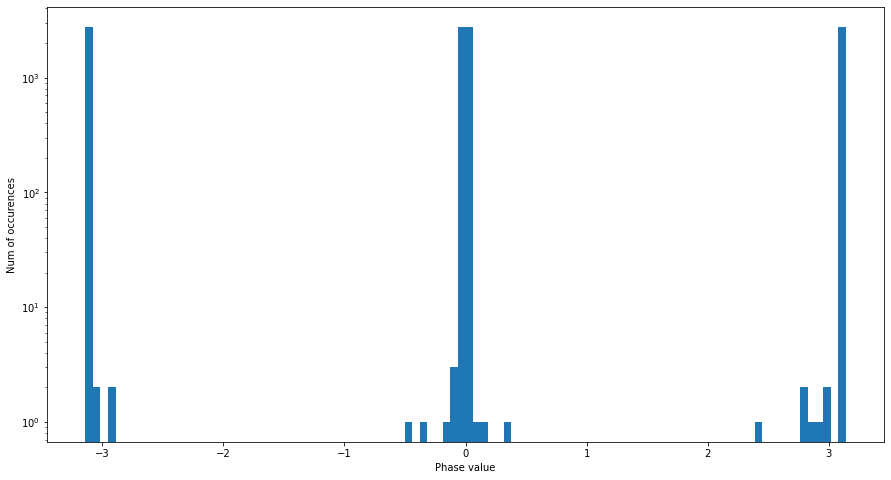
We note that the values of phase lie in \((-\pi, \pi]\) as this is the image domain of atan2.
Before we start modifying the values of the STFT we will convert the STFT values back to a PCM encoded signal which we can easily playback.
display(Audio(
data=librosa.istft(data_fft, hop_length=HOP_LENGTH, win_length=WIN_LENGTH),
rate=sr,
))
We can hear that although we transformed it via STFT and the inverse STFT we still can reconstruct the original signal perfectly.
Modifying the FFT matrix¶
As we have access to the FFT matrix we can also its values. This allows us to modify the signal in a different way than just having access to the PCM values.
Modifying values¶
We start by removing the phase information by setting it to 0. We can achive this by using the absolute value \(|z| = \sqrt{x^2 + y^2}\), which defines the amplitude, as the real component and leave the imaginary component zero.
display(Audio(
data=librosa.istft(np.abs(data_fft), hop_length=HOP_LENGTH, win_length=WIN_LENGTH),
rate=sr,
))
We can already hear that this introduces an amplitude modulation as all sine waves start at the same time.
Therefore the beginning of each window we have silence as \(\sin(\text{freq}*\text{phase}) = 0\) if \(\text{phase}=0\).
The WIN_LENGTH and HOP_LENGTH define the characteristics of the amplitude modulation in this case.
We can also take a look how the signal sounds if we conjugate our complex values. Given a complex number \(z:=x+iy\) the conjugate of \(z\) is defined via \(\overline{z}:=x-iy\). We therefore change the phase of our values but do not modify its amplitude as \(|z| = |\overline{z}|\).
Source: https://commons.wikimedia.org/wiki/File:Complex_conjugate_picture.svg
display(Audio(
data=librosa.istft(np.conj(data_fft), hop_length=HOP_LENGTH, win_length=WIN_LENGTH),
rate=sr,
))
This introduces an interesting shift of time for each frequency bin. It behaves like a multiband delay whose delay times (negative and positive) get shuffled at each time window, although the shuffeling is not random but is dependent on its other parts.
Modifying order¶
We can use some array slicing in numpy to re-arange the order of our FFT matrix. From working-with-matrices we know that Python and numpy use the notion of
start:stop:step_size
for the selection and re-arranging of arrays where, if not defined, the start is 0 and the stop is the end of the array and the step size is one.
Therefore ::-1 reverses the array.
We use : to keep the dimension untouced.
We start by inversing the second axis which is the time domain.
display(Audio(
data=librosa.istft(
stft_matrix=data_fft[:, ::-1],
hop_length=HOP_LENGTH,
win_length=WIN_LENGTH
),
rate=sr,
))
We can also reverse the order of the bins which is the first dimension of our FFT matrix.
display(Audio(
data=librosa.istft(
stft_matrix=data_fft[::-1, :],
hop_length=HOP_LENGTH,
win_length=WIN_LENGTH
),
rate=sr,
))
We can also scramble the fft bins for both dimensions.
For this we use np.arange to create a series of \(n\) numbers and use np.random.permutation to permutate those numbers into a new ordering.
We then can use this reordered series of numbers as the indices of our FFT matrix which will reorder it.
We start by re-arranging along the bin axis.
display(Audio(
data=librosa.istft(
stft_matrix=data_fft[np.random.permutation(np.arange(0, data_fft.shape[0])), :],
hop_length=HOP_LENGTH,
win_length=WIN_LENGTH
),
rate=sr,
))
And now allong the time axis.
display(Audio(
data=librosa.istft(
stft_matrix=data_fft[
:,
np.random.permutation(np.arange(0, data_fft.shape[1]))
],
hop_length=HOP_LENGTH,
win_length=WIN_LENGTH
),
rate=sr,
))
We can also reset the phase to 0 via the \(\text{abs}\) function (as seen above), mute all even frequency bins on even time windows and vice versa.
copy_fft = np.copy(data_fft)
# reset phase
copy_fft = np.abs(copy_fft)
# mute even frequencies on even time
copy_fft[::2, ::2] = 0
# vice versa
copy_fft[1::2, 1::2] = 0
display(Audio(
data=librosa.istft(
stft_matrix=copy_fft,
hop_length=HOP_LENGTH,
win_length=WIN_LENGTH
),
rate=sr,
))
Spectogram¶
When working with sound files we often use a spectogram to display the amplitude of a frequency at a specific time. As this 3 dimensional vector is rather difficult to plot on a 2 dimensional screen we tend to transcend the dimension of amplitude into a color representation. The main difference to FFT is that we are not interested in the phase of our signal as we have no need to re-construct the original signal from the visual representation but the spectogram relies on FFT as well.
Librosa has a built-in way to calculate the mel spectogram.
data_spec = librosa.feature.melspectrogram(data, sr=sr, hop_length=HOP_LENGTH, win_length=WIN_LENGTH, n_fft=N_FFT)
data_spec.shape
(128, 123)
data_spec
array([[6.1129981e-01, 6.9615573e-02, 9.2120416e-02, ..., 3.2474060e-02,
4.0274881e-02, 2.6646625e-02],
[1.1160107e+00, 8.6185392e-03, 1.9175248e-02, ..., 9.1835700e-02,
3.9624672e-02, 2.2018056e-02],
[2.1654862e-01, 7.8314170e-03, 8.7827826e-03, ..., 1.6649935e-02,
8.5100941e-03, 7.2227293e-03],
...,
[3.0609652e-05, 3.5152865e-05, 5.4686083e-05, ..., 5.9910279e-05,
6.2108615e-05, 4.9236445e-05],
[4.1872801e-05, 4.2257307e-05, 4.6182246e-05, ..., 5.3868574e-05,
5.9915208e-05, 4.2955351e-05],
[4.8739221e-05, 3.9803021e-05, 4.5088007e-05, ..., 5.3943058e-05,
5.6274108e-05, 5.2992524e-05]], dtype=float32)
data_spec.shape
(128, 123)
Right now we are still using the notion of amplitude from our PCM signal but the more common way to talk about the volume of signals is decibel - thankfully librosa has already a built-in function to help us out on the conversion here and also a function which takes care of the scaling of our plot.
librosa.display.specshow(
librosa.amplitude_to_db(data_spec),
x_axis='time',
y_axis='mel',
sr=sr,
fmax=20000,
hop_length=HOP_LENGTH,
)
plt.colorbar()
plt.show()

Re-Arranging the spectogram¶
The basic idea was to re-order the windows of our spectogram. Of course we could use any ordering but we want to focus here on an aproach which acounts the characteritics and patterns of our data which is one of the fundamental tasks of data science.
As an trivial ordering of elements is only possible in a single dimension we could use a dimensionality reduction algorithm to reduce the number of our frequency bins to 1. By reducing it to 1 dimension we obtain a new ordering of our material which is based by the similarity by the content of each time window instead of the original temperal ordering.
We will use 2 algorithms: PCA and TSNE and compare how the differ. Also we will train each algorithm on a reduction to 1 and to 2 dimensions - 1 dimension is necessary for our ordering but we can observe the characteristics of the algorithm better when using a 2 dimensional plot.
from sklearn.decomposition import PCA
from sklearn.manifold import TSNE
pca = PCA(n_components=1)
pca_2 = PCA(n_components=2)
tsne = TSNE(n_components=1, random_state=42)
tsne_2 = TSNE(n_components=2, random_state=42)
Instead of working on the raw spectogram data we transfer it to a decibel range which reflects our hearing and perception of amplitude in a better way.
We could also skip go back to amplitude range to compare the performance of the algorithms.
data_spec_db = librosa.amplitude_to_db(data_spec)
PCA¶
data_pca = pca.fit_transform(data_spec_db.T)
plt.scatter(x=data_pca, y=np.zeros(data_pca.shape), c=np.arange(len(data_pca)))
#plt.scatter(x=data_pca, y=np.arange(len(data_pca)), c=np.arange(len(data_pca)))
plt.colorbar(location='bottom');
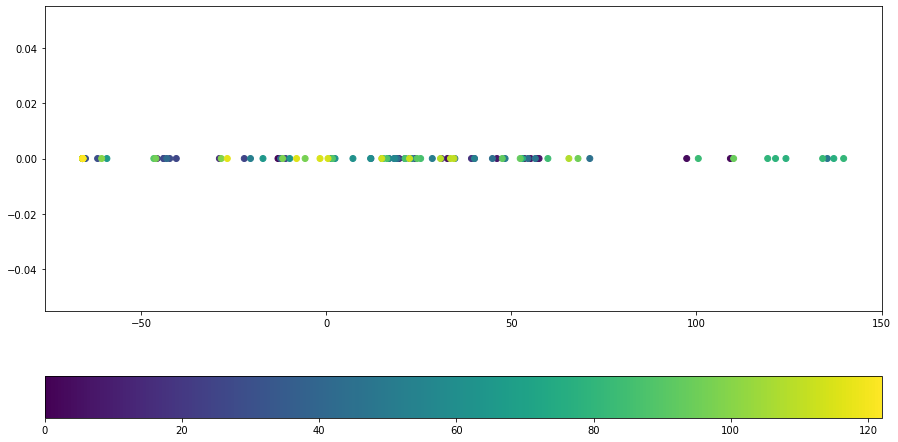
data_pca_2 = pca_2.fit_transform(data_spec_db.T)
plt.scatter(x=data_pca_2[:, 0], y=data_pca_2[:, 1], c=np.arange((len(data_pca))))
plt.colorbar(location='bottom');
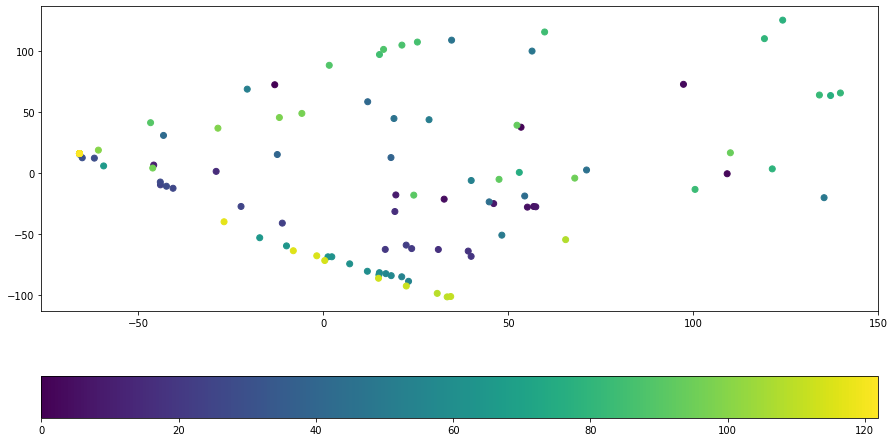
T-sne¶
data_tsne = tsne.fit_transform(data_spec_db.T)
plt.scatter(x=data_tsne, y=np.zeros(data_tsne.shape), c=np.arange(len(data_tsne)))
plt.colorbar(location='bottom');
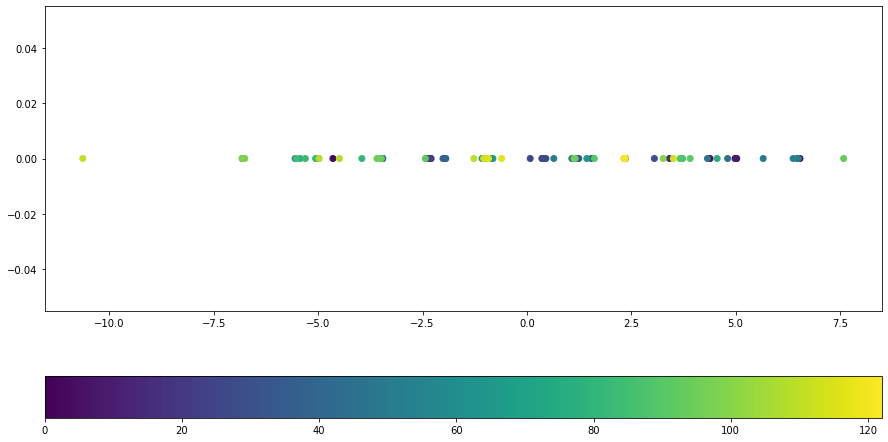
data_tsne_2 = tsne_2.fit_transform(data_spec_db.T)
plt.scatter(x=data_tsne_2[:, 0], y=data_tsne_2[:, 1], c=np.arange(len(data_tsne)))
plt.colorbar(location='bottom');
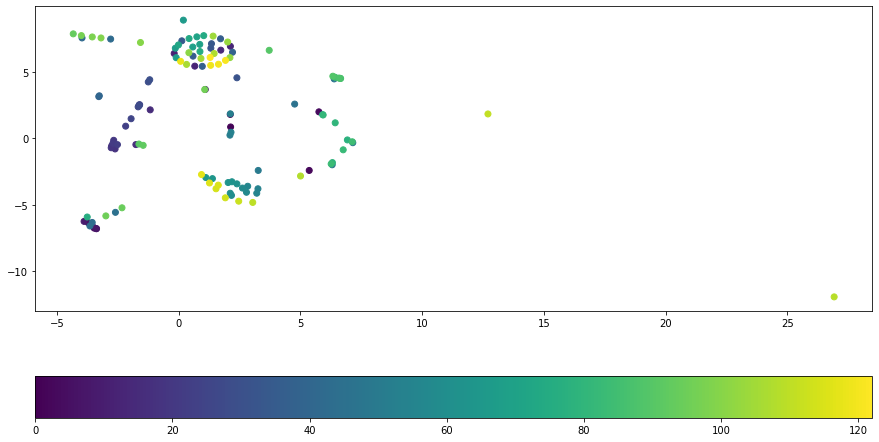
When comparing the arragements of PCA and TSNE we see that the structure of TSNE is much mor distinct and has more structure which is reflected by our hearing.
There are some ways to make PCA also distinguish the structure by pre-processing (e.g. amp to decibel) the data and therefore shifting the focus on the aspects of data we want to distinguish.
Reordering the spectorgram¶
We can use the 1-dimensional re-ordering of our spectogram as a new ordering of our spectogram.
order = np.argsort(data_pca[:, 0])
order[[0, 1, 2, 3, 4, 5, 6]]
array([122, 120, 121, 32, 33, 34, 35])
pca_order = np.argsort(data_pca[:, 0])
print(f"PCA reordering:\n{pca_order}")
fft_pca_order = data_fft[:, pca_order]
signal_pca = librosa.istft(fft_pca_order, hop_length=HOP_LENGTH, win_length=WIN_LENGTH)
display(Audio(signal_pca, rate=sr))
PCA reordering:
[122 120 121 32 33 34 35 36 37 38 73 72 71 70 69 68 67 75
74 13 14 103 12 105 106 104 102 101 118 119 107 11 31 30 29 100
66 90 96 10 27 24 42 28 26 15 99 117 25 52 65 0 40 98
23 64 116 97 115 114 63 89 62 61 60 41 113 59 58 85 88 20
56 39 57 46 16 9 54 87 22 112 55 21 91 86 51 109 17 4
110 111 47 18 19 53 44 8 92 50 93 76 1 43 5 48 6 7
84 108 95 45 3 83 2 94 80 79 78 82 49 77 81]
tsne_order = np.argsort(data_tsne[:, 0])
print(f"tSNE reordering:\n{tsne_order}")
fft_tsne_order = data_fft[:, tsne_order]
signal_tsne = librosa.istft(fft_tsne_order, hop_length=HOP_LENGTH, win_length=WIN_LENGTH)
display(Audio(signal_tsne, rate=sr))
tSNE reordering:
[111 99 42 41 98 97 48 84 78 82 79 49 83 80 109 2 108 81
94 76 95 43 6 5 44 92 19 16 18 22 20 21 17 39 23 40
110 59 60 112 113 55 54 57 58 56 61 62 63 115 116 64 65 117
25 26 28 24 27 51 47 86 96 85 10 29 66 31 90 107 104 102
69 70 103 101 105 106 122 38 67 34 37 73 72 71 12 14 75 13
121 120 119 118 33 11 74 32 68 36 35 30 100 15 114 89 88 87
91 46 3 77 45 4 9 8 7 50 53 1 52 0 93]
Re-writing into a class¶
After we have know the basic procedure of our algorithm we can wrap everything into a class to make it more reusable and also have a single command to run an experiment which allows us to speed up the search for more aesthetic pramaters.
from typing import Optional, Callable
class SpectReorder:
def __init__(
self,
file_path: str,
hop_length: Optional[int] = None,
win_length: Optional[int] = None,
n_fft: Optional[int] = None,
sr: Optional[int] = None,
pre_process: Optional[Callable] = None,
):
self.file_path = file_path
self._data, self._sr = librosa.load(file_path, sr=sr, mono=True)
self.hop_length = hop_length if hop_length else int(self._sr/2)
self.win_length = win_length if win_length else int(self._sr)
self.n_fft = n_fft if n_fft else self.win_length
self._fft = librosa.stft(
self._data,
n_fft=self.n_fft,
hop_length=self.hop_length,
win_length=self.win_length,
)
self._spectogram = librosa.feature.melspectrogram(
self._data,
sr=self._sr,
hop_length=self.hop_length,
win_length=self.win_length,
n_fft=self.n_fft
)
self.pre_process = pre_process if pre_process else lambda x: librosa.amplitude_to_db(x)
def run_algorithm(self, dim_reduction = None):
dim_reduction = dim_reduction if dim_reduction else TSNE(n_components=1)
spect = self.pre_process(self._spectogram)
spect_reduced = dim_reduction.fit_transform(spect.T)
fft_re_order = self._fft[:, np.argsort(spect_reduced[:, 0])]
reordered_signal = librosa.istft(
fft_re_order,
hop_length=self.hop_length,
win_length=self.win_length,
)
return reordered_signal
experiment = SpectReorder('violin.flac', hop_length=400, win_length=2000, sr=44100)
signal = experiment.run_algorithm()
display(Audio(signal, rate=experiment._sr))
Now we can tweak all parameters of our algorithm in a single line and compare multiple results because the config of the algorithm is now attached to the instance of our experiment and not shared globally by every experiment.
Fine tuning the results¶
While listening to the results at least the PCA aproach relies too much on the amplitude of the signal and not on its
volume_scaling = lambda x: librosa.amplitude_to_db(x/np.sum(x, axis=1)[:, np.newaxis])
experiment = SpectReorder(
'trumpet.flac',
hop_length=400,
win_length=2000,
sr=44100,
pre_process=volume_scaling
)
signal = experiment.run_algorithm()
display(Audio(signal, rate=experiment._sr))
We can also apply a scaling on each frequency so that he higher frequencies are less important for our clustering than the low frequencies. We can use an inversed log scale for this and multiply a matrix of these value to our spectogram.
log_scaling = lambda x: np.matmul(np.repeat(np.log(np.arange(len(x)+1, 1, -1))[np.newaxis, :], len(x), axis=0), x)
experiment = SpectReorder(
'violin.flac',
hop_length=400,
win_length=2000,
sr=44100,
pre_process=log_scaling
)
signal = experiment.run_algorithm()
display(Audio(signal, rate=experiment._sr))
We can now combine these two pre-processing steps into one by nesting the functions.
experiment = SpectReorder(
'violin.flac',
hop_length=400,
win_length=2000,
sr=44100,
pre_process=lambda x: log_scaling(volume_scaling(x))
)
signal = experiment.run_algorithm()
display(Audio(signal, rate=experiment._sr))
Where to go from here¶
Currently we are not considering the cluster of similar grains. Instead of playing them in their ordinal order we could play them according to the distance of their reduced dimensionality.
We also restricted ourselves to a 1 dimensional reduction as the ordering then becomes trivial. But by moving to higher dimensions the replacing of samples could be composed via n nearest neighbors.